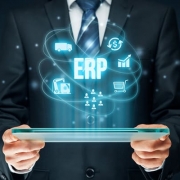9 Ways in Which Innovation is Changing ERP Technology
Enterprise Resource Planning (ERP) software has become more than its initial function of managing day-to-day business activities. ERP is more pervasive, responsive, and adaptable than ever before. An article on MacSources notes the evolution of ERP and how its rebirth has been a decade-long process that has resulted in a more versatile and multifaceted instrument that has assisted businesses of different sizes in re-inventing their company strategy. Being utilized in many aspects of business and across mobile, social and traditional channels, this technology has since evolved thanks to the latest innovations integrated with ERP systems.
Cloud-based Solutions. “Currently, everything ERP has to offer may be run on the cloud or on-premise, but this may change in the coming years. The development of Industry 4.0 necessitates more intuitive business software and rapid access to data on the go, which the cloud platform is better suited to.”
IoT. “Without a doubt, the Internet of Things has enormous potential to improve the corporate sector. IoT has enabled commercial organizations to follow and study the flow of information as well as computing processes in real-time. The analytics enabled by IoT have provided immediate access to specialized company knowledge, allowing management to make well-informed, timely judgments and choices.”
Wearable Technology. “The integration of ERP software development and wearable technology has numerous advantages. This integration allows the transmission of real-time data, which can help to reduce errors and losses by tracking shipments in manufacturing businesses. Additionally, data reduplication can be greatly reduced with real-time data access. Wearable technology and ERP software will also allow for faster decision-making, allowing top authorities to purchase critical goods quickly by utilizing portable devices.”
Big Data. “Big Data and ERP software can be very effective if used concurrently. For example, it can help assess the current pattern of customer behavior by examining data that is already available as well as data gathered by automated devices.”
AI. “Customer service is the primary area in which AI (Artificial Intelligence) and ERP software can be combined to create a more successful and helpful software product. AI-enabled ERP technology can be beneficial to the HR department, for example, it can assist HR in identifying the vulnerabilities of inefficient employees who are unable to complete tasks on time.”
CRM, SCM, BI, and ERP as One Solution. “When all four technologies are used together, an organization can produce enormous revenues by enhancing its work efficiency. Almost all large-scale industries now use ERP-based solutions. Many firms now provide supply chain management software that includes ERP-based functions designed to execute specific tasks. And not only SCM but also the majority of CRM and BI solutions are deployed using ERP software.”
RFID. “RFID (Radio Frequency Identification) is one of the most commonly used terms in the market for automatic identification and data collecting. This technology allows users to identify, monitor, and detect practically any object. It is most commonly used in inventory and warehousing, distribution, access control, and asset tracking. An ERP and RFID system has three primary advantages: tracking of goods and materials in real-time, dynamic updates of information on a box or label, and hands-free and quick product information scanning with no human interaction required.”
Mobile ERP. “Industries have recognized the value of allowing their managers and staff to access data in real-time on a mobile device or tablet and collaborate from any location. Employees can use mobile ERP to manage orders, quotes, and prepositions while working on the pitch from any device, improve customer service with full access to client history, contracts, and product-specific information, have access to all corporate information while working away from the office, and enter all important information as it is collected in the field, avoiding the need to retype it into the back-end system.”
Social ERP. “Social ERP is an excellent step toward consumer collaboration and engagement. It is unnecessary to integrate your ERP systems with external social networking platforms. Instead, you can use social ERP to imitate the functionality of, say, Facebook. The only difference is that it will be safer and more secure within your ERP system.”
Today, ERP has made a presence in almost every aspect of the business environment, creating a shift in how firms employ ERP systems. The article concludes that ERP innovation will allow you to make more effective decisions both in the short and the long term.



